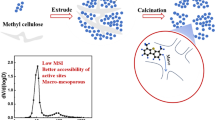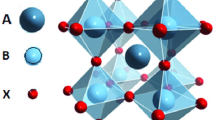Abstract
This work shows the performance of MoOx–VOx based bimetallic catalysts tested on the oxidative desulfurization (ODS) process of refractory dibenzothiophenic compounds using H2O2 as an oxidant. The catalytic activity was related with the oxidation state of molybdenum and vanadium surface species and with the interaction of both metals. The prepared molybdenum–vanadium oxides supported on alumina were subjected to reduction treatments at different temperature to obtain molybdenum and vanadium species with different oxidation state. Catalysts were characterized by their textural properties, scanning electron microscopy–energy dispersive X-ray, X-ray diffraction, temperature programed reduction and X-ray photoelectron spectroscopy. The characterization results showed that metal interactions promote the generation of highly active tetrahedral molybdenum species and isolated vanadium species, which increase the ODS performance of Mo–V based catalysts compared with their respective monometallic catalysts. Also, it was observed that combination of Mo6+, Mo4+ and V4+ superficial species promoted the ODS catalytic activity.




Similar content being viewed by others
References
Song C (2003) An overview of new approaches to deep desulfurization for ultra-clean gasoline, diesel fuel and jet fuel. Catal Today 86:211–263
Babich IV, Moulijn JA (2003) Science and technology of novel processes for deep desulfurization of oil refinery streams: a review. Fuel 82:607–631
Srivastava VC (2012) An evaluation of desulfurization technologies for sulfur removal from liquid fuels. RSC Adv 2:759–783
Secretary of the Environment MX (2016). http://www.sedema.df.gob.mx/sedema/. Accessed 28 Feb 2017
Environmental Protection Agency USA (2016). https://www3.epa.gov/. Accessed 28 Feb 2017
Official Website of the European Union (2016). http://europa.eu/index_en.htm. Accessed 28 Feb 2017
Stanislaus A, Marafi A, Rana MS (2010) Recent advances in the science and technology of ultra low sulfur diesel (ULSD) production. Catal Today 153:1–68
Ito E, Rob van Veen JA (2006) On novel processes for removing sulphur from refinery streams. Catal Today 116:446–460
Ismagilov Z, Yashnik S, Kerzhentsev M, Parmon V, Bourane A, Al-Shahrani FM, Hajji AA, Koseoglu OR (2011) Oxidative desulfurization of hydrocarbon fuels. Catal Rev 53:199–255
Kwang-Eun J, Tae-Wan K, Joo-Wan K, Ho-Jeong C, Chul-Ung K, Young-Kwon P, Soon-Yong J (2013) Selective oxidation of refractory sulfur compounds for the production of low sulfur transportation fuel. Korean J Chem Eng 30:509–517
García-Gutiérrez JL, Lozano IP, Hernández-Pérez F, Laredo GC, Jimenez-Cruz F (2012) R&D in oxidative desulfurization of fuels technologies: from chemistry to patents. Recent Pat Chem Eng 3(5):174–196
Feng M (2010) Review on recent patents in sulfur removal from liquid fuels by oxidative desulfurization (ODS) process. Recent Pat Chem Eng 3:30–37
Anisimov AV, Tarakanova AV (2009) Oxidative desulfurization of hydrocarbon raw materials. Russ J Gen Chem 79(6):1264–1273
Qian EW (2008) Development of novel nonhydrogenation desulfurization process—oxidative desulfurization of distillate. J Jpn Pet Inst 51:14–31
Alvarez-Amparán MA, Cedeño-Caero L (2017) MoOx–VOx based catalysts for the oxidative desulfurization of refractory compounds. Influence of MoOx–VOx interaction on the catalytic performance. Catal Today 282:133–139
González-García O, Cedeño-Caero L (2009) V–Mo based catalysts for oxidative desulfurization of diesel fuel. Catal Today 148:42–48
González-García O, Cedeño-Caero L (2010) V–Mo based catalysts for ODS of diesel fuel. Part II. Catalytic performance and stability after redox cycles. Catal Today 150:237–243
Wan Azelee WAB, Rusmidah A, Abdul Aziz Abdul K, Wan NAWM (2012) Effect of transition metal oxides catalysts on oxidative desulfurization of model diesel. Fuel Process Technol 101:78–84
Gómez-Bernal H, Cedeño-Caero L, Gutiérrez-Alejandre A (2009) Liquid phase oxidation of dibenzothiophene with alumina-supported vanadium oxide catalysts: an alternative to deep desulfurization of diesel. Catal Today 142:227–233
Cedeño-Caero L, Alvarez-Amparan MA (2014) Performance of molybdenum oxide in spent hydrodesulfurization catalysts applied on the oxidative desulfurization process of dibenzothiophene compounds. Reac Kinet Mech Cat 113:115–131
Cedeño-Caero L, Gomez-Bernal H, Fraustro-Cuevas A, Guerra-Gomez HD, Cuevas-Garcia R (2008) Oxidative desulfurization of synthetic diesel using supported catalysts: Part III. Support effect on vanadium-based catalysts. Catal Today 133–135:244–254
Silversmit G, Depla D, Poelman H, Marin GB, De Gryse R (2004) Determination of the V2p XPS binding energies for different vanadium oxidation states (V5+ to V0+). J Electron Spectrosc Relat Phenom 135:167–175
Demeter M, Neumann M, Reichelt W (2000) Mixed-valence vanadium oxides studied by XPS. Surf Sci 454–456:41–44
Wua QH, Thissena A, Jaegermanna W, Liub M (2004) Photoelectron spectroscopy study of oxygen vacancy on vanadium oxides surface. Appl Surf Sci 236:473–478
Suchorskia Y, Rihko-Struckmann L, Klose F, Ye Y, Alandjiyska M, Sundmacher K, Weiss H (2005) Evolution of oxidation states in vanadium-based catalysts under conventional XPS conditions. Appl Surf Sci 249:231–237
Mendialdua J, Casanova R, Barbaux Y (1995) XPS studies of V2O5, V6O13, VO2 and V2O3. J Electron Spectrosc Relat Phenom 71:249–261
Baltrusaitisa J, Mendoza-Sanchez JB, Fernandez V, Veenstra R, Dukstienee N, Roberts A, Fairleyga N (2015) Generalized molybdenum oxide surface chemical state XPS determination via informed amorphous sample model. Appl Surf Sci 326:151–161
Spevack PA, McIntyre NS (1993) A Raman and XPS investigation of supported molybdenum oxide thin films. 1. Calcination and reduction studies. J Phys Chem 97:11020–11030
Choi JG, Thompson LT (1996) XPS study of as-prepared and reduced molybdenum oxides. Appl Surf Sci 93:143–149
Criinert W, Stakheev YA, Feldhaus R, Anders K, Shpiro ES, Minachev KM (1991) Analysis of Mo(3d) XPS spectra of supported mo catalysts: an alternative approach. J Phys Chem 95:1323–1328
Alvarez-Amparán MA, Rodríguez-Gomeztagle J, Cedeño-Caero L (2015) Effect of the preparation method of MoO3/Al2O3 catalysts for the oxidative desulfurization of a diesel model (paper in Spanish). Efecto del método de preparación de catalizadores de MoO3/Al2O3 para la desulfuración oxidativa de un diesel modelo. Superf y Vacío 28:40–47
Arnoldy P, de Jonge JCM, Moulijn JA (1985) Temperature-programmed reduction of MoO3, and MoO2. J Phys Chem 89(21):4517–4526
Cordero RL, Llambias FJG, Agudo AL (1991) Temperature-programmed reduction and zeta potential studies of the structure of Mo/O3Al2O3 and Mo/O3SiO2 catalysts effect of the impregnation pH and molybdenum loading. Appl Catal 74:125–136
Cordero RL, Agudo AL (2000) Effect of water extraction on the surface properties of Mo/Al2O3 and NiMo/Al2O3 hydrotreating catalysts. Appl Catal A 202:23–35
Wachs IE, Chena Y, Jih-Mirn J, Briand LE, Tanaka T (2003) Molecular structure and reactivity of the Group V metal oxides. Catal Today 78:13–24
Weckhuysen BM, Keller DE (2003) Chemistry, spectroscopy and the role of supported vanadium oxides in heterogeneous catalysis. Catal Today 78:25–46
Reddy EP, Varma RS (2004) Preparation, characterization, and activity of Al2O3-supported V2O5 catalysts. J Catal 221:93–101
Surnev S, Ramsey MG, Netzer FP (2003) Vanadium oxide surface studies. Prog Surf Sci 73:117–165
Hari-Babu B, Venkateswara-Rao KT, Surendar M, Sai-Prasad PS, Lingaiah N (2015) Influence of promoters on the structural and catalytic functionalities of V2O5/Al2O3 catalysts for the ammoxidation of ortho-chlorotoluene. Reac Kinet Mech Cat 114:121–134
Bernal HG, Caero LC (2005) Solvent effects during oxidation–extraction desulfurization process of aromatic sulfur compounds from fuels. Int J Chem React Eng. doi:10.2202/1542-6580.1246
Bielafiski A, Najbar M (1997) V2O5–MoO3 catalysts for benzene oxidation. Appl Catal A 157:223–261
Bañares MA, Khatib SJ (2004) Structure–activity relationships in alumina-supported molybdena–vanadia catalysts for propane oxidative dehydrogenation. Catal Today 96:251–257
Solsona B, Dejoz A, Garcia T, Concepción P, Lopez Nieto JM, Vázquez MI, Navarro MT (2006) Molybdenum–vanadium supported on mesoporous alumina catalysts for the oxidative dehydrogenation of ethane. Catal Today 117:228–233
Dai H, Bell AT, Iglesia E (2004) Effects of molybdena on the catalytic properties of vanadia domains supported on alumina for oxidative dehydrogenation of propane. J Catal 221:491–499
Acknowledgements
This study was financial supported by the Project Support Program for Research and Technological Innovation (PAPIIT) of UNAM (Projects IN115514 and IN115317) and IMP Project D.0047. Marco Antonio Alvarez-Amparán acknowledge the PhD National Scholarship (Scholarship Number 245610) to National Council of Science and Technology of Mexico (CONACyT). We thank C. Salcedo (XRD) and I. Puente (SEM–EDX) for the technical assistance.
Author information
Authors and Affiliations
Corresponding author
Rights and permissions
About this article
Cite this article
Alvarez-Amparán, M.A., Cedeño-Caero, L., Cortes-Jácome, M.A. et al. Relationship between the catalytic activity and Mo–V surface species in bimetallic catalysts for the oxidative desulfurization of dibenzothiophenic compounds. Reac Kinet Mech Cat 122, 869–885 (2017). https://doi.org/10.1007/s11144-017-1237-4
Received:
Accepted:
Published:
Issue Date:
DOI: https://doi.org/10.1007/s11144-017-1237-4




